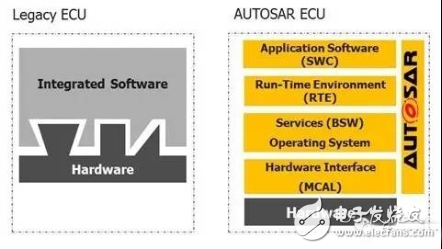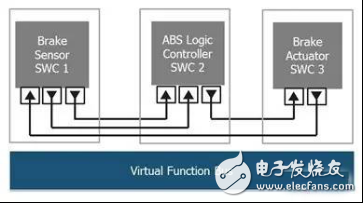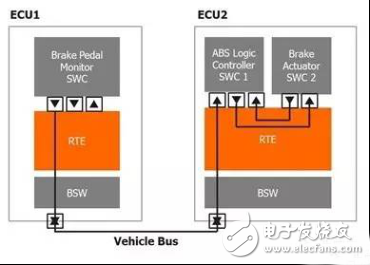Since its inception in 2003, the AUTOSAR (Automotive Open Systems Architecture) Alliance has been working to change the way in which vehicle networks and electronic control units (ECUs) are designed. AUTOSAR provides an industry standard method for original equipment manufacturers (OEMs) and their Tier 1 suppliers to design and develop ECUs located in modern vehicle centers. This standard will help reduce human error in the design process and provide suppliers and manufacturers with a clear, machine-readable data format to exchange design information. This article will explore some of the expected business benefits of the AUTOSAR adoption strategy and explain some basic terms and design approaches.
Members of the AUTOSAR Alliance include automotive OEMs and a support ecosystem of parts and service providers. The Alliance's mission is to create and establish global open standards for automotive electrical/electronic (E/E) architecture. The standard provides support at the vehicle architecture level, allowing OEM network designers to design and manage complex relationships between vehicle functions, and also supports the vendor's detailed definition of the individual ECU interface prior to manufacturing.
Why use AUTOSAR instead?
A modern luxury car may contain up to 100 ECUs, from simple sensor interfaces to sophisticated entertainment information and telematics units. The risk of switching them all to AUTOSAR methods and standards all at once is high, but the original equipment manufacturers and Tier 1 suppliers make such changes with many benefits. It is expected that by 2020, all vehicles will have some AUTOSAR-based ECUs, so the standard cannot be ignored.
Some of the reasons and benefits of switching to AUTOSAR include:
Better reuse of electronic control units in new automotive platforms and architectures
Better use of pre-verified and tested software components (representing vehicle functionality)
Reduce downstream design errors - a set of AUTOSAR methods allows functions to be defined and verified at the architectural level
Reduce overall hardware costs by improving network efficiency and feature utilization
Reduces the cost of overall network architecture analysis and design review
Improved communication between original equipment manufacturers and Tier 1 suppliers due to the use of a standardized data exchange format (AUTOSARXML or arxml)
Whether or not the ECU needs to be redesigned or improved throughout the internal design cycle, switching to AUTOSAR can speed up design adjustments. For example, the workflow of a new tool, or to help maintain compliance with the ISO26262 standard, will change the workflow of the work, and the AUTOSAR method can be used to import the process at the same time. Regardless of how the adjustments are implemented, the first time spent on the AUTOSAR electronic control unit design project takes longer than the existing/traditional design process because designers need time to become familiar with the new approach. But then you can bring results that save costs and improve efficiency. It is also possible to shift the traditional ECU assets to the AUTOSAR standard. By using the "AUTOSAR Wrapper" concept, important existing and proven electronic control unit application codes can be reused. Enables the AUTOSAR package to be imported into other pure AUTOSARECUs. This will help reduce the risk of switching to the AUTOSAR approach.
What is AUTOSAR?
Essentially, AUTOSAR provides a standard ECU interface definition that allows designers to specify the reusable standardized software layers and components required in each automotive ECU. This standard is not affected by hardware, which means that the application software and hardware platform are independent of each other. Application software developers can clearly specify the details of each car function in the application software without worrying about the relevant software services and hardware interfaces. In the past, software and hardware were tightly integrated, making portability and reusability difficult (Figure 1).

Figure 1: Separating application software from hardware.
Separating design from hardware decisions enables vehicle manufacturers/OEMs to design top-down based on the required vehicle functionality. The Virtual Function Bus (VFB) concept that exists at this design time allows all software electronic control units to be interconnected and tested. This allows designers to focus on the application layer rather than the underlying software infrastructure. Application software components (SWCs) are also independent of other application software components through the use of virtual function buses. The software component sends an output signal to the virtual function bus, which in turn transmits the information to the input port of the target component. AUTOSAR defines the input and output ports, as well as the format of the exchanged information. This abstracted approach enables all vehicle software functions and interface interaction verification to be implemented prior to defining the relevant hardware. Design adjustments are therefore much easier, and all functions are defined as software components on the virtual function bus (Figure 2).

Figure 2: Testing software components on a virtual function bus.
Although the virtual function bus does not provide information on how the ECU is distributed and interconnected in real vehicles, it is a useful benchmark for architectural design time. Timing checks and interface definitions are available for all signals in the vehicle.
Once the designer is satisfied with the features, these features are imaged or aggregated into a specific hardware electronic control unit. AUTOSAR supports the imaging and aggregation process of software components. A complex ECU may contain many software components that can be organized hierarchically if necessary.

Figure 3: Assigning software functions to a real electronic control unit.
Rice Mill,Rice Mill Machine,Small Rice Milling Machine,Rice Mill Equipment
Hunan Furui Mechanical and Electrical Equipment Manufacturing Co., Ltd. , https://www.thresher.nl
